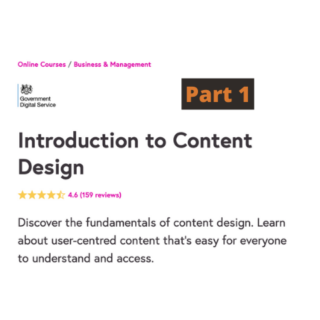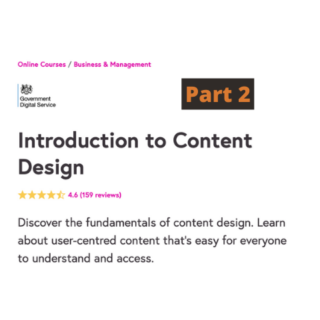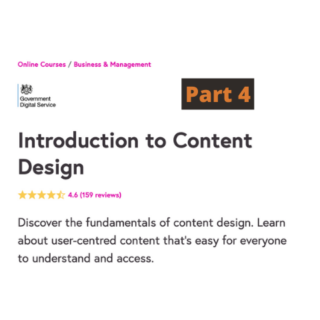Our Content Specialist, Ben, describes what he’s learnt about User Research in the GOV.UK Content Design course
Over the past two weeks, our content specialist, Ben has been learning about Content Design. In this blog he talks about the course module on User Research.
Why User Research is important to content design
Coming into the course, I knew that users were paramount to creating any digital service. Relying on users to communicate any issues they find on a service is incredibly important before the service goes live. And that’s where user research starts.
As a content creator, I’ll be the first to say that I knew users were important, but never delved truly into the depths of user research. The extent as to which I’ve carried out user research on my content is by consulting our partners over at the Shaw Trust Accessibility Services. Whilst consulting them and understanding how their disabled users interact with content was incredibly valuable, this course gave me additional insight into user research.
Understanding how users interact and complete a service, and their pain points, can give a real insight into what content is needed.
Preparing user research
I’ve never done a focused user research session before, and it was great to understand the processes involved in user research, including the following.
Finding participants
This was touched on briefly in the course. It’s pretty obvious that no user research would be complete without users. It used the following as examples of user groups:
- a particular demographic (people aged 18 -24)
- a specific target user group (such as small business owners or hospital staff)
- a particular experience (people who have recently moved home, or applied for a government grant)
- a problematic situation (such as people who’ve lost an important document)
- particular ways of accessing your service (specifically those who rely on a screen reader, or who only access the internet at a library).
It’s important to choose a wide variety of people when selecting users. And is essential to have disabled members carry out user testing too.
Preparing questions for users
Very simply, with user research you need to understand two elements of their digital journey:
- What users currently do
- What the difficulties in the current journey are
Asking the right questions to users
This is also something I’d never really considered before now. It’s all well and good asking the users to give feedback on their experience using a service, but not so good if you don’t ask the correct questions. By that I mean, asking the questions that give you the most points of improvement and actionable insights into issues they encounter.
Assessing the questions you ask your users
Below are some examples, both good and bad, that were presented in the course. Before evaluating the answers, they all seemed like valid questions, but this is not the case.
- Do you find it frustrating to find the information at the moment?
- How do you find the information at the moment?
- Do you use the website to find information about bin collection?
- What information do you need to know about bins?
- Would you like a service which added a calendar reminder to your email account about bins?
- What does your local council recycle?
Question 1 is a leading question. It suggests that the service is problematic, and whilst it’s bound to give a user researcher some ammunition on what’s wrong with the service, there’s no opportunity for the user to explain what’s good. Knowing what’s good is worthwhile as it’s allows you to evaluate what works.
Question 2 is a good, open question and allows you to understand the process a user goes through to find information.
Question 3 has a yes or no response so will limit the user in what they can respond with.
Question 4 is a great question and allows you to understand what information may be missing with your content. It will allow users to explain what they need to know about bin collections.
Question 5 offers a solution and asks for an opinion. Questions about user experience should not influence a user. Creating the solution off the back of feedback is fine, but creating solutions before understanding the needs of the user is not the most effective method. It could be that other solutions are more effective, this gives no option for users to suggest other solutions.
Question 6 is testing a user’s knowledge, whilst this is good for understanding what a user knows, it is not the purpose of a user research question.
Good user research interviews
The course also touched on user research interviews and how good questions can be incorporated into a user reader interview.
The important part of a user research interview is to create a discussion guide that includes:
- Your introduction script tells the participant who you are, explaining the research and reminding them that the interview is recorded.
- The interview topics, including starter and follow-up questions that prompt open answers.
- A planning checklist to make sure you have everything you need.
The course also touched on how user research interviews should be designed to create an environment where the user is able to talk freely regarding the questions.
My thoughts on week 2 of the course
I came into this module with a view that I knew how to create accessible digital content, and much of the technicalities discussed were not new to me. This was only a very brief aspect of the course, though.
I find myself now being drawn deeper into user research, and how good user research can inform a content creator of what content to create. As mentioned in last week’s blog, content writers very easily fall into the trap of producing content for the sake of producing content.
Not only did I learn that the user has to be at the very centre of every content decision we make, I learnt about how to interact with users and how to conduct effective research with users of a digital service.
Whilst it is no easy feat in an organisation of less than 10 of us, the course pointed in the direction of community collaboration or ideas on how best to conduct user research as part of a small team. I’m looking forward to seeing how this can be implemented into the way we work at HeX.



